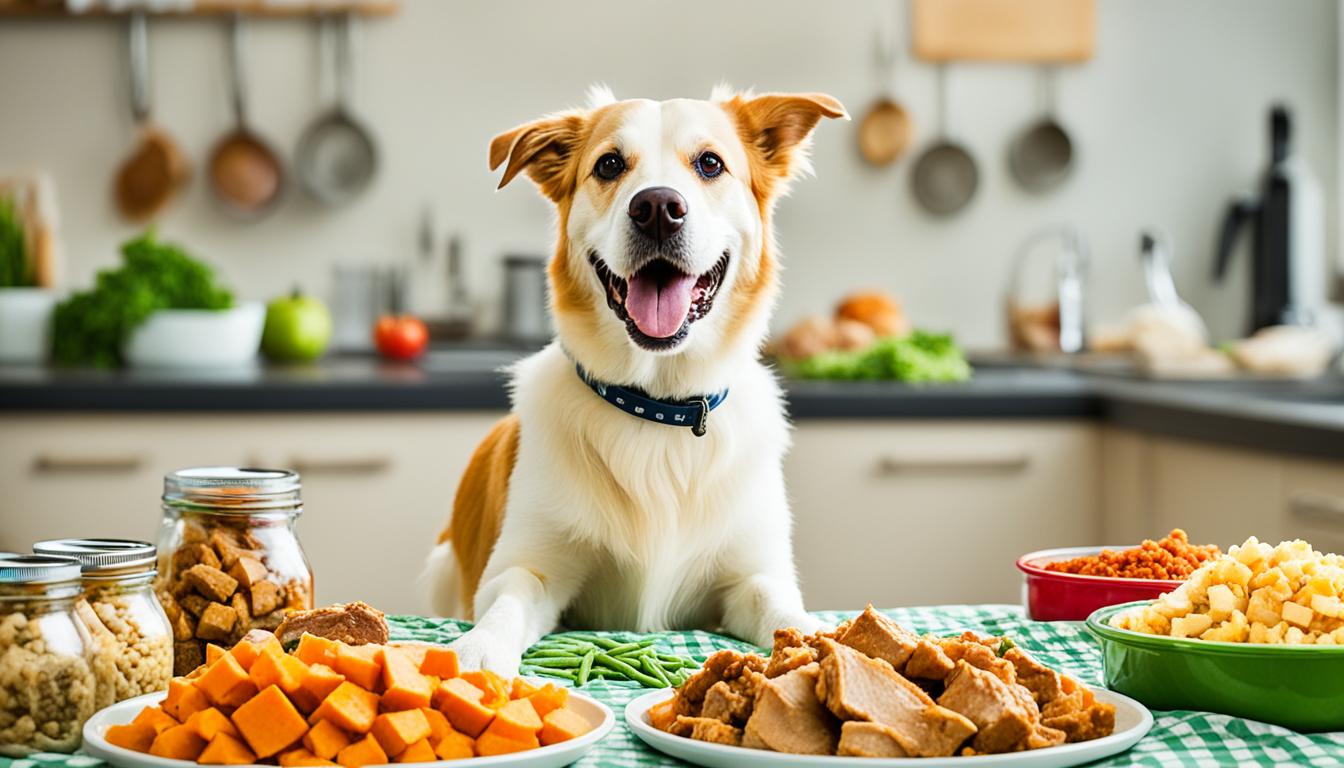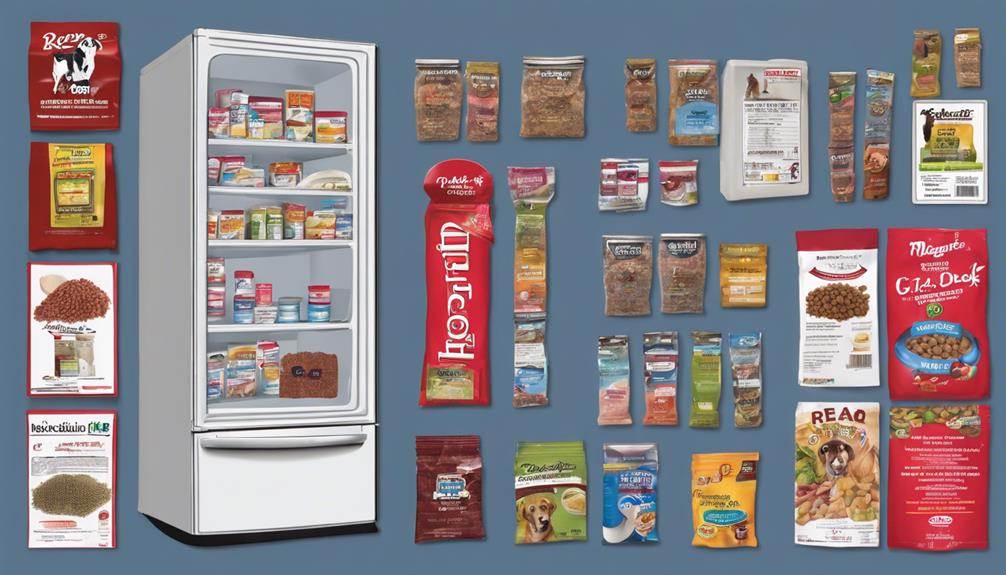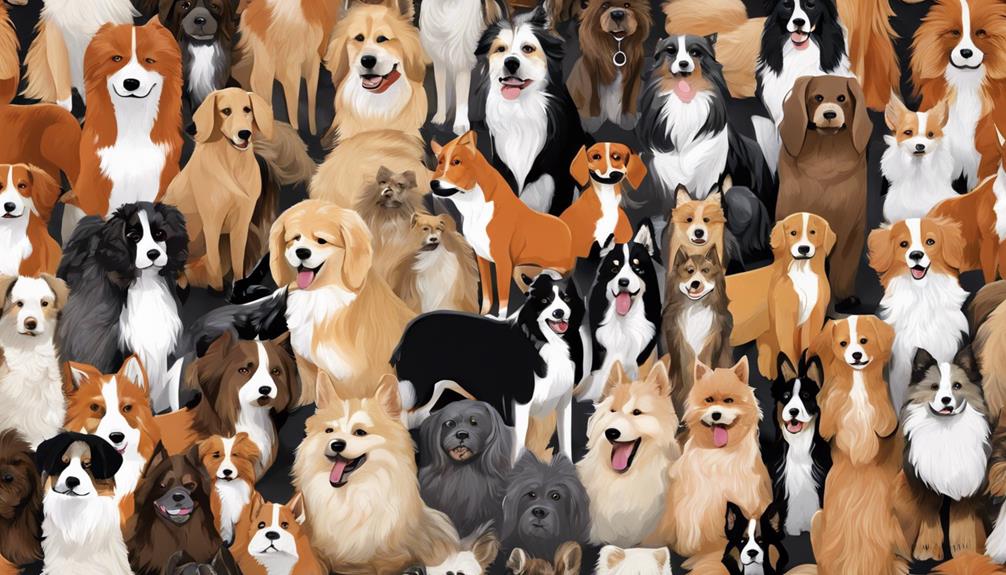Did you know that around 80% of dog owners in the United States give table scraps to their furry companions?
Thanksgiving leftovers can be tempting to share with our dogs, but it’s important to know which foods are safe for them. According to veterinary experts consulted by the American Kennel Club, there are certain foods that are safe and healthy for dogs to consume in moderation.
Key Takeaways:
- Not all human foods are safe for dogs to consume.
- Turkey meat, sweet potatoes, and pumpkin are safe for dogs in plain, unseasoned form.
- Avoid giving dogs bones, alcohol, fatty foods, and overly sweet or salty foods.
- Some seemingly harmless foods like grapes, raisins, and nuts can be toxic to dogs.
- It’s crucial to prioritize the health of our furry friends and stick to their regular diets.
Safe Foods for Dogs: Bread, Cashews, Cheese
Dogs can enjoy certain human foods as a treat, but it’s essential to understand which foods are safe for them. In this section, we will explore the safety of bread, cashews, and cheese for our furry friends.
Bread for Dogs
Bread in its plain form is safe for dogs to eat in small amounts. However, it’s crucial to ensure that the bread doesn’t contain any spices or raisins, as these can be harmful to dogs. While bread won’t provide any significant health benefits, it can serve as an occasional treat.
Cashews for Dogs
Cashews can be a delightful and nutritious snack for dogs when given in moderation. Unsalted cashews are safe for dogs to consume, and they can provide a good source of healthy fats, proteins, and vitamins. It’s important, though, to remember that cashews should only be given as an occasional treat due to their high-fat content.
The number of cashews a dog can eat depends on the dog’s size and overall health. According to PetMD, the general guidelines for safe feeding portion sizes are as follows:
- Extra-small dog (2-20 pounds): One or two cashews or ¼ tablespoon of cashew butter twice a day
- Small dog (21-30 pounds): Two to three cashews or ½ tablespoon of cashew butter twice a day.
- Medium dog (31-50 pounds): Five to six cashews or ¾ tablespoons of cashew butter twice a day.
- Large dog (51-90 pounds): 10-12 cashews or one tablespoon of cashew butter twice a day.
- Extra-large dog (91+ pounds): 12-18 cashews or 1 ½-2 tablespoons of cashew butter twice a day.
It’s important to note that these are general guidelines and treats, including cashews, should only make up about 10% of a dog’s daily caloric intake. Additionally, cashews should be given sparingly and not as a regular part of the dog’s diet due to their high fat content, which can lead to obesity and pancreatitis. Always consult with a veterinarian before introducing new foods into your dog’s diet, especially if your dog has specific health conditions or dietary restrictions.
Cheese for Dogs
Cheese is often a favorite among dogs, but it’s important to be mindful of a few factors. Dogs can enjoy cheese in moderation, as long as they are not lactose intolerant. Lower-fat varieties like cottage cheese or mozzarella are preferred options. Remember that cheese should only be given as a treat and not as a regular part of their diet. If you notice any adverse reactions, such as an upset stomach or diarrhea, consult with your veterinarian.
| Foods | Safety | Considerations |
|---|---|---|
| Bread | Safe in plain form | Avoid spices and raisins |
| Cashews | Safe in moderate amounts | Unsalted and occasional treat |
| Cheese | Safe in moderation | Avoid if lactose intolerant |
Remember to always introduce new foods gradually and monitor your dog for any adverse reactions. If you have any concerns or questions about your dog’s diet, it’s best to consult with a veterinarian for personalized advice.
Foods to Avoid Giving Dogs: Chocolate, Cinnamon, Coconut
When it comes to feeding your furry friend, it’s important to know which foods are safe and which ones should be avoided. Some foods that are harmless or even healthy for humans can actually be harmful or toxic to dogs. In this section, we’ll discuss three specific foods that you should avoid giving to your canine companion: chocolate, cinnamon, and coconut.
The Dangers of Chocolate for Dogs
While chocolate is a delicious treat for humans, it is one of the most dangerous foods for dogs. Chocolate contains a compound called methylxanthines, which can cause a range of symptoms in dogs, including diarrhea, vomiting, seizures, irregular heart function, and even death. Even small amounts of chocolate, especially dark chocolate, can be toxic to dogs.

To keep your dog safe, it’s essential to keep all forms of chocolate, including chocolate bars, cocoa powder, and baking chocolate, out of their reach. If you suspect that your dog has ingested chocolate, it’s crucial to contact your veterinarian immediately for guidance and treatment.
The Caution with Cinnamon
While cinnamon is generally considered safe for dogs, it can cause irritation in their mouths and digestive issues if ingested in large amounts. Some dogs may also have an allergic reaction to cinnamon. Therefore, it’s best to avoid giving cinnamon to your furry friend or use it sparingly in small quantities.
“Cinnamon may irritate a dog’s mouth and cause digestive issues if ingested in excessive amounts. It’s always better to err on the side of caution and avoid giving cinnamon to your dog.”
The Benefits of Coconut for Dogs
In contrast to chocolate and cinnamon, coconut is safe for dogs and can even provide some health benefits. Coconut contains a fatty acid called lauric acid, which has antimicrobial properties. It can help combat bacteria and viruses, promote healthy skin conditions, and improve your dog’s overall well-being.
Coconut can be offered to dogs in different forms, such as coconut oil, coconut milk, or raw coconut meat. However, it’s important to introduce coconut gradually into their diet and monitor for any adverse reactions. Additionally, it’s crucial to avoid giving dogs coconut water, as it can contain high levels of potassium that may be harmful to dogs.
In summary, while chocolate and cinnamon should be avoided for dogs, coconut can be a safe and beneficial addition to their diet. It’s important to prioritize your dog’s health and well-being by being aware of the foods that are safe to share with them and those that should be avoided.
| Foods to Avoid | Reasons |
|---|---|
| Chocolate | Contains methylxanthines that can be toxic to dogs |
| Cinnamon | May cause mouth irritation and digestive issues |
| Coconut water | May contain high levels of potassium |
Other Safe and Unsafe Foods for Dogs: Corn, Eggs, Fish
Dogs can enjoy a variety of foods, but it’s important for pet owners to be aware of which ones are safe and which ones should be avoided. In this section, we’ll explore the safety of three common food items that often find their way into a dog’s bowl: corn, eggs, and fish.
Safe Foods for Dogs: Corn
Corn is a popular ingredient in many dog foods due to its nutritional value. It is a good source of carbohydrates, fiber, and antioxidants. Dogs can safely consume corn, but it’s important to note that the cob can be difficult for them to digest and may cause intestinal blockage. Pet owners should remove the corn kernels from the cob before feeding it to their dogs to prevent any potential complications.
Safe Foods for Dogs: Eggs
When fully cooked and prepared without any seasoning, eggs can be a safe and nutritious treat for dogs. Eggs are an excellent source of protein and contain essential vitamins and minerals. They can be served scrambled or hard-boiled, but avoid adding any salt, spices, or oils. It’s important to note that some dogs may be allergic to eggs, so it’s recommended to introduce them gradually and monitor for any adverse reactions.
Safe Foods for Dogs: Fish
Fish, particularly salmon and sardines, can provide numerous health benefits for dogs. These fish are rich in omega-3 fatty acids, which promote healthy skin and coat, support brain function, and reduce inflammation. However, it’s crucial to remove all tiny bones from fish before feeding them to dogs, as they can pose a choking hazard or cause injury to the digestive tract. Additionally, it’s important to note that dogs should never be given raw or undercooked fish, as it may contain harmful bacteria or parasites.
It’s always essential to consult with a veterinarian before introducing any new foods into your dog’s diet, especially if your dog has any specific dietary restrictions or health concerns.
| Food | Safety |
|---|---|
| Corn | Safe, but remove the cob to prevent blockage |
| Eggs | Safe when fully cooked and plain, but monitor for allergies |
| Fish | Safe when fully cooked and bone-free, avoid raw or undercooked |

Foods to Avoid Giving Dogs: Garlic, Ham, Honey
Dogs should not eat certain foods as they can be harmful to their health. Some of these foods include garlic, ham, and honey.
Garlic
Garlic is toxic to dogs and should be avoided. It contains substances that can cause anemia, elevated heart rate, weakness, and even collapse. Onions, leeks, and chives, which are part of the Allium family, are also toxic to dogs and should be kept away from them.
Ham
While ham is generally safe for dogs to eat in small quantities, it should be given sparingly. Ham is high in sodium and fat, which can lead to an upset stomach and other health issues if consumed in excess. It’s best to opt for leaner meats that are free from added seasonings or preservatives.
Honey
Honey can be given to dogs in small amounts and may have some health benefits, such as soothing throat irritation or aiding in digestion. However, it’s important to introduce honey gradually and monitor for any adverse reactions. Some dogs may have allergies or sensitivities to honey, so it’s essential to observe their response and consult with a veterinarian if needed.
“It’s crucial to be aware of the foods that are harmful to dogs and to avoid giving them these foods. Remember that what may be safe for humans may not be safe for our furry friends.”
To summarize, garlic, ham, and honey are foods to avoid giving to dogs. They can pose various health risks, from toxicity to digestive issues. It’s always best to prioritize the well-being of our pets and consult with a veterinarian if you have any concerns or questions about specific foods.
| Foods to Avoid | Reasons |
|---|---|
| Garlic | Contains substances that can cause anemia, elevated heart rate, weakness, and collapse. Onions, leeks, and chives are also toxic. |
| Ham | High in sodium and fat, can lead to upset stomach and other health issues if consumed in excess. |
| Honey | Should be introduced gradually, monitor for adverse reactions. Some dogs may have allergies or sensitivities. |

Foods to Avoid Giving Dogs: Ice Cream, Macadamia Nuts, Milk
Dogs should not eat ice cream due to its high sugar content and the potential for lactose intolerance. Some dogs have an intolerance to lactose and may not digest milk well, so it’s best to give them water instead. Macadamia nuts are highly poisonous to dogs and can cause vomiting, increased body temperature, inability to walk, and lethargy. Milk, while generally safe for dogs in small quantities, should be given with caution as some dogs are lactose intolerant.
| Foods to Avoid for Dogs | Reasons to Avoid |
|---|---|
| Ice Cream | High sugar content; potential for lactose intolerance |
| Macadamia Nuts | Highly poisonous; vomiting, increased body temperature, inability to walk, lethargy |
| Milk | Some dogs are lactose intolerant; give water instead |
It’s important for dog owners to be aware of the foods that can be harmful to their furry friends. While some human foods may seem harmless, they can have serious consequences for dogs. In particular, ice cream should be avoided due to its high sugar content and potential for causing upset stomachs and weight gain. Additionally, some dogs may have difficulty digesting lactose found in milk, leading to gastrointestinal discomfort. Macadamia nuts are especially dangerous for dogs, as they can cause severe symptoms that require immediate veterinary attention.
Remember, responsible pet owners prioritize their dogs’ health and well-being by avoiding these foods:
- Ice cream
- Macadamia nuts
- Milk
Instead of ice cream, consider giving your dog frozen treats specifically made for canines. And always consult with a veterinarian before introducing any new food to your dog’s diet.

Safe Foods for Cats: Cooked Meat, Vegetables, Yogurt, Cheese
Cats can enjoy a variety of safe and nutritious foods. Here are some options:
Cooked Meat:
Cats can safely consume cooked meats such as beef, turkey, chicken, or fish. It is important to finely chop the meat into small pieces and remove any seasonings, skins, bones, gravy, and fatty parts before feeding them to your cat.
Vegetables:
While not all cats appreciate vegetables, some may enjoy a few pieces of cooked, finely chopped green beans. Green beans can provide additional fiber and nutrients to your cat’s diet. However, it’s crucial to introduce vegetables gradually and monitor your cat’s response to ensure they are well-tolerated.
Yogurt:
Small amounts of plain yogurt can be given to cats as a treat. Yogurt contains beneficial probiotics that can support your cat’s digestive health. However, it is important to choose plain yogurt without any added sugars or artificial flavors.
Cheese:
A few shavings of cheese can also be a delight for your cat. Cats are generally lactose intolerant, so it’s essential to offer cheese in small amounts and monitor for any digestive issues. Opt for low-lactose options like cheddar or Swiss cheese.
Remember, while these foods can be included in your cat’s diet, it’s crucial to do so in moderation. Ensure a balanced and complete diet by consulting with your veterinarian and following their recommendations.
| Foods | Benefits | Portion Size |
|---|---|---|
| Cooked Meat | Good source of protein | Small, finely chopped pieces |
| Vegetables | Additional fiber and nutrients | A few pieces of cooked, finely chopped green beans |
| Yogurt | Provides beneficial probiotics | Small amounts of plain yogurt |
| Cheese | A tasty treat | A few shavings |

“Cats can safely enjoy cooked meats such as beef, turkey, chicken, or fish, but it’s important to remove any seasonings, skins, bones, gravy, and fatty parts before feeding them. A few pieces of cooked, finely chopped green beans can be a good option for cats who enjoy vegetables. Small amounts of plain yogurt or a few shavings of cheese can also be given as treats.”
Sources:
- PetMD: “People Foods for Cats: What’s Safe and What’s Not”
- American Society for the Prevention of Cruelty to Animals (ASPCA): “People Foods to Avoid Feeding Your Pets”
- The Spruce Pets: “Human Food for Cats: What Can Cats Eat?”
Cautions for Dogs and Cats: Stick to Normal Diet, Avoid Overindulgence
While it’s okay to share safe foods with dogs and cats on occasion, it’s important to prioritize their normal diets and avoid overindulgence. Even safe foods can upset their stomachs if they are not accustomed to them. It’s essential to educate family members and guests about the cautions of sharing harmful foods with pets. Proper disposal of kitchen scraps is crucial to prevent accidental ingestion.
- Avoid overindulgence: It can be tempting to spoil our furry friends with treats, but moderation is key. Too much of even safe foods can lead to digestive issues and obesity, both of which can have negative impacts on their overall health.
- Stick to their normal diets: Dogs and cats have specific dietary requirements to ensure they receive balanced nutrition. Deviating from their regular diets can put them at risk of nutritional imbalances and potential health issues.
- Educate family members and guests: Not everyone may be aware of the foods that are harmful to dogs and cats. It’s important to communicate with family members and guests to prevent accidental sharing of foods that can be toxic or cause harm.
- Properly dispose of kitchen scraps: Leftover food scraps, especially those containing harmful ingredients, should be disposed of in a secure trash can. This will prevent pets from rummaging through the trash and accidentally ingesting harmful foods.
By exercising caution, maintaining their normal diets, and avoiding overindulgence, pet owners can ensure the well-being and longevity of their beloved four-legged companions.

Importance of Secure Trash Cans to Prevent Accidental Ingestion
Trash cans containing kitchen scraps pose a potential danger to our furry friends. Pets, such as dogs and cats, are often tempted by the smell and sight of leftover food, leading to accidental ingestion of harmful substances. This can result in gastrointestinal issues, discomfort, and in severe cases, even emergency room visits. To ensure the well-being of our pets, it is crucial to use secure trash cans that are inaccessible to them.
When it comes to disposing of food waste, especially after holiday feasts, it is essential to consider the potential hazards it poses to our pets. Leftovers such as turkey carcass, meat scraps, sweet potato casserole, or any other items that may be tasty but potentially harmful should be discarded properly. Secure trash cans prevent our pets from accessing these tempting but dangerous food items.
By using secure trash cans, we minimize the risk of accidental ingestion of harmful foods by our beloved dogs and cats. This simple preventative measure plays a vital role in keeping our pets safe and healthy. It is our responsibility to ensure that the food waste we dispose of does not pose a threat to our furry companions.
Benefits of Secure Trash Cans:
Using secure trash cans provides several benefits in terms of pet safety and overall well-being. Consider the following advantages:
- Preventing Accidental Ingestion: Secure trash cans keep harmful foods out of the reach of pets, reducing the chances of accidental ingestion and potential health issues.
- Minimizing Gastrointestinal Discomfort: By properly disposing of food waste, we prevent pets from experiencing discomfort, digestive problems, and potential visits to the veterinarian.
- Promoting a Safe Environment: A secure trash can helps maintain a safe environment for pets by eliminating the risk of ingesting toxic substances found in food waste.
By investing in secure trash cans, we create a safer living environment for our pets, minimizing the risk of illness or injury caused by accidental consumption of harmful foods.
| Benefits of Secure Trash Cans |
|---|
| Preventing Accidental Ingestion |
| Minimizing Gastrointestinal Discomfort |
| Promoting a Safe Environment |
Protecting our pets from the potential hazards of food waste is crucial for their well-being. By using secure trash cans, we can prevent accidental ingestion and minimize the risk of illness or injury. Let’s prioritize proper food disposal and take the necessary steps to keep our furry friends safe and healthy.

Conclusion
When it comes to sharing food with our beloved dogs and cats, it’s essential to prioritize their health and well-being. While it can be tempting to give them a taste of our Thanksgiving leftovers, not all foods are safe for their consumption. By understanding which foods are safe and which ones to avoid, we can ensure that our furry friends stay happy and healthy during the holiday season.
Safe food leftovers for dogs and cats include plain, unseasoned turkey meat, sweet potatoes, and pumpkin. These can be shared with our pets in moderation. However, it’s crucial to steer clear of foods that are harmful to them, such as chocolate, grapes, onions, garlic, and macadamia nuts. High-fat foods should also be avoided as they can lead to digestive issues.
By sticking to their regular diets and introducing safe foods gradually, we can avoid upsetting their stomachs. Always consult with a veterinarian if you have any concerns or notice any adverse reactions. Remember, our pets rely on us to take care of their dietary needs, so let’s share safe food with them and ensure their health and happiness throughout the holiday season and beyond.










